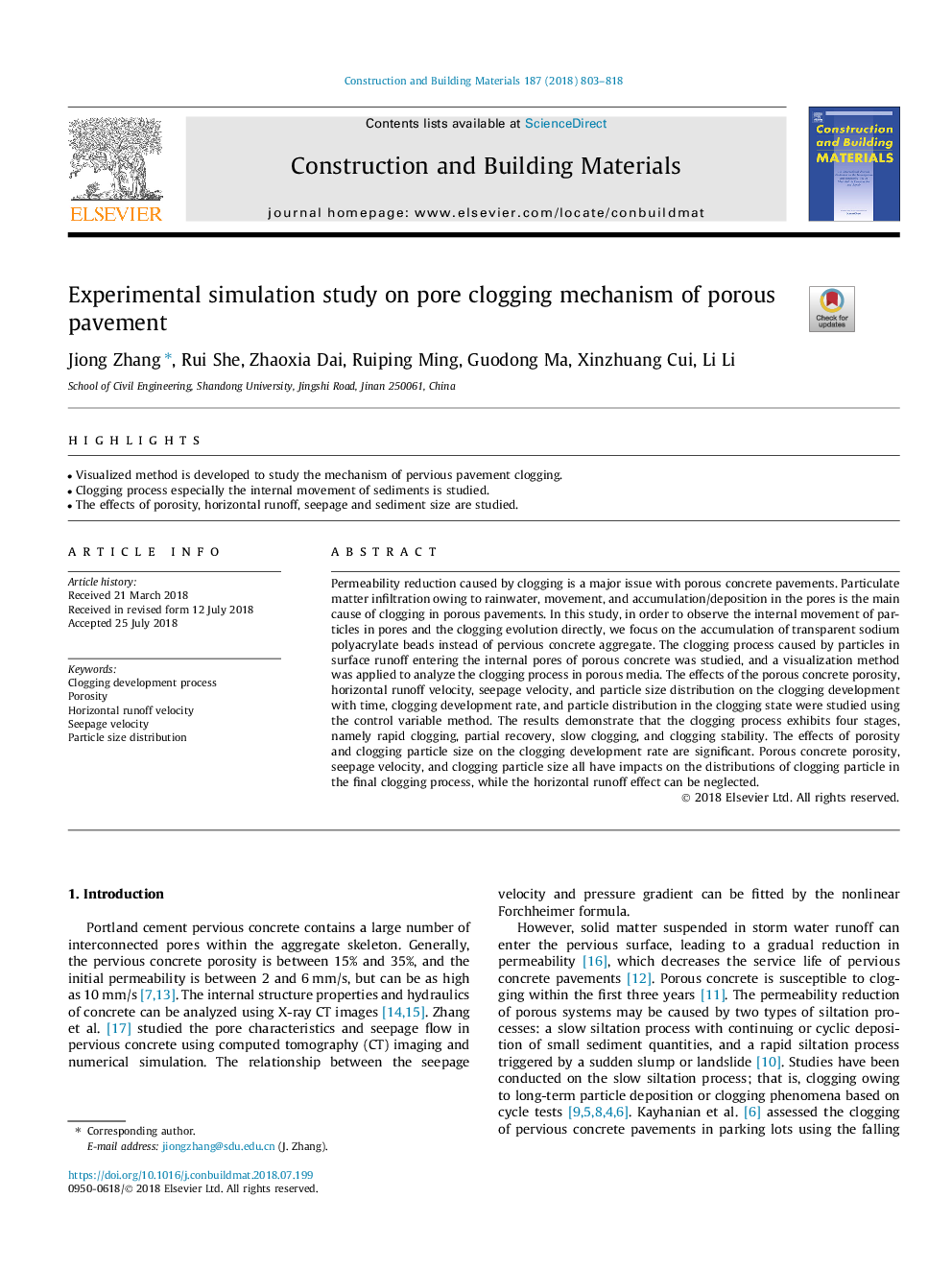| کد مقاله | کد نشریه | سال انتشار | مقاله انگلیسی | نسخه تمام متن |
|---|---|---|---|---|
| 6711528 | 1428719 | 2018 | 16 صفحه PDF | دانلود رایگان |
عنوان انگلیسی مقاله ISI
Experimental simulation study on pore clogging mechanism of porous pavement
ترجمه فارسی عنوان
مطالعه شبیه سازی تجربی بر روی مکانیسم مسدود شدن منافذ روسازی متخلخل
دانلود مقاله + سفارش ترجمه
دانلود مقاله ISI انگلیسی
رایگان برای ایرانیان
کلمات کلیدی
فرایند انهدام فرآیند، قطر بینی، سرعت روان افقی، سرعت شستشو، توزیع اندازه ذرات،
ترجمه چکیده
کاهش نفوذ پذیری ناشی از مسدود شدن یک مسئله مهم با روکش های بتنی متخلخل است. نفوذ مواد جامد به دلیل آب باران، حرکت و تجمع / رسوب در منافذ، علت اصلی مسدود شدن در روسازی متخلخل است. در این مطالعه، به منظور مشاهده حرکت داخلی ذرات در منافذ و تکامل مسدود سازی به طور مستقیم، ما تمرکز بر تجمع دانه های پلی اکریلات سدیم شفاف به جای دانه بتن پیش ساخته است. فرآیند مسدود شدن ناشی از ذرات در روان سطحی وارد شدن منافذ داخلی بتن متخلخل مورد مطالعه قرار گرفت و برای تجزیه و تحلیل روند مسدود شدن در رسانه های متخلخل، یک روش تجسم استفاده شد. با استفاده از روش متغیر کنترل، اثرات تخلخل بتنی متخلخل، سرعت تخلخل افقی، سرعت نفوذ و توزیع اندازه ذرات بر میزان انبساط با زمان، سرعت رشد مسدود و توزیع ذرات در حالت مسدود شدن مورد بررسی قرار گرفت. نتایج نشان می دهد که فرایند مسدود شدن چهار مرحله را نشان می دهد: مسدود شدن سریع، بازیابی جزئی، مسدود شدن آهسته و ثبات اشباع. اثرات تخلخل و اندازه ذرات مسدود شده بر میزان انبساط قابل توجه است. تخلخل بتنی متخلخل، سرعت نفوذ و اندازه ذرات مسدود شده، بر روی توزیع ذرات مسدود شده در فرآیند مسدود شدن نهایی تاثیر می گذارد، در حالی که اثر رواناب افقی را می توان نادیده گرفت.
موضوعات مرتبط
مهندسی و علوم پایه
سایر رشته های مهندسی
مهندسی عمران و سازه
چکیده انگلیسی
Permeability reduction caused by clogging is a major issue with porous concrete pavements. Particulate matter infiltration owing to rainwater, movement, and accumulation/deposition in the pores is the main cause of clogging in porous pavements. In this study, in order to observe the internal movement of particles in pores and the clogging evolution directly, we focus on the accumulation of transparent sodium polyacrylate beads instead of pervious concrete aggregate. The clogging process caused by particles in surface runoff entering the internal pores of porous concrete was studied, and a visualization method was applied to analyze the clogging process in porous media. The effects of the porous concrete porosity, horizontal runoff velocity, seepage velocity, and particle size distribution on the clogging development with time, clogging development rate, and particle distribution in the clogging state were studied using the control variable method. The results demonstrate that the clogging process exhibits four stages, namely rapid clogging, partial recovery, slow clogging, and clogging stability. The effects of porosity and clogging particle size on the clogging development rate are significant. Porous concrete porosity, seepage velocity, and clogging particle size all have impacts on the distributions of clogging particle in the final clogging process, while the horizontal runoff effect can be neglected.
ناشر
Database: Elsevier - ScienceDirect (ساینس دایرکت)
Journal: Construction and Building Materials - Volume 187, 30 October 2018, Pages 803-818
Journal: Construction and Building Materials - Volume 187, 30 October 2018, Pages 803-818
نویسندگان
Jiong Zhang, Rui She, Zhaoxia Dai, Ruiping Ming, Guodong Ma, Xinzhuang Cui, Li Li,
